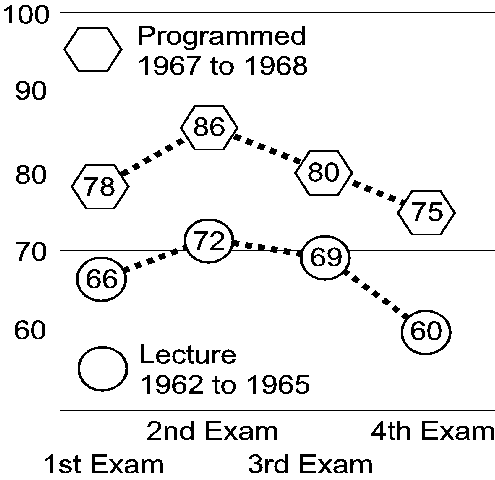
Helen L. Plants, Associate Professor Theoretical and Applied Mechanics and Curriculum. and Instruction
Wallace S. Venable, Instructor, Theoretical and Applied Mechanics
West Virginia University
The teacher who uses programmed instruction has a choice of many roles. Each has strengths and weaknesses in both the affective and cognitive domains, but none its clearly optimum. Several roles are described and examined.
In the beginning days of Programmed Instruction (PI) there was a deep distrust of the new approach. Despite the gains that were claimed for programmed courses; acceptance was minimal. Faculties simply refused to try it.
The reason was not difficult to determine The advocates of the program hailed it as the method of the future, a means by which that awful anachronism, the teacher, would be removed from the teaching process. Rather naturally, teachers resented this. In addition to their natural egoistic distaste for being replaced by anything many teachers had an intuitive feeling that the teacher played a unique and important role in education.
As time passed, more and more attention was paid, not to eliminating the teacher by the use of programmed instruction, but to integrating him into the new instructional package. Many people began to attempt to define and explore the role that the teacher plays in a programmed course.
The admission by programmers that the teacher did, indeed, have a role, led to a willingness on the part of teachers to consider the use of programmed instruction. In essence, the teaching community exacted payment for the use of innovative methods and that price was a piece of the action.
Since teachers demand - and, in the opinion of the authors, should have - an active role in any teaching process, it is the purpose of this paper to examine a variety of roles for the instructor using programmed instruction.
It is not enough however, simply to look at what the teacher does, or tries to do. Teacher-behavior and teacher-decisions actually determine the entire instructional system. For that reason we shall describe a variety of instructional systems, some designed, and some accidental, with which we have experimented.
The data that we report is sketchy, indicating directions rather than conclusions. Furthermore, since the statistical analysis of these data is not yet complete, we have preferred not to include our incomplete analysis. Thus, this paper may be considered a somewhat anecdotal preview of more rigorous work to follow.
The first system we attempted did not appear to differ greatly from the standard lecture system. The programmed materials as they became available were simply used as a sort of supplements replacing the homework normally required in the course. Lectures, far from being dead, continued on their accustomed schedule.
Several things happened. First of all, in the cognitive domain, excellent results were obtained. Using earlier classes as a basis of comparison; the programmed classes were clearly ahead. (Figure 1). The students were happy with the class, with the material, and particularly with their grades.

An interesting phenomenon was noted. Under this system, students who had previously had difficulty did much better. In fact, the grade distribution for students on probation was the same as that for students who had satisfactory records. (Figure 2). It is postulated that the probationary students included a large number who, while capable of learning difficult work, were ill-adapted to learning it from lectures. Given a different teaching approach they became as competent as their classmates. This alone night constitute a reason for teaching some sections with programs.
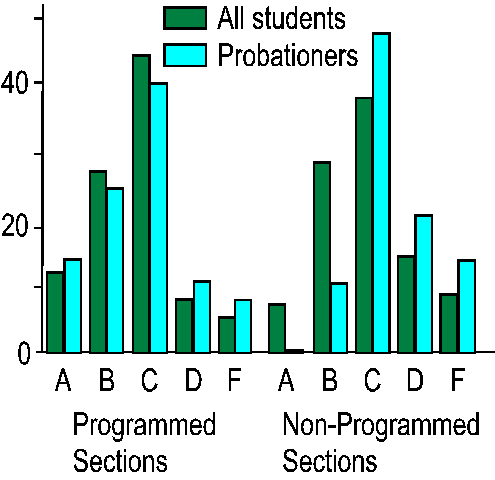
The business-as-usual system of using programmed instruction seems from our experience to have been quite successful. However, in the experience of West Virginia University it has been self-extinguishing.
The problem is that students are bored with the lectures and tend to make the fact evident to the teacher. They resist learning from either the textbook or the lecture and wish to rely on the programmed material alone. This is quite shattering to the teacher and one of two things happens. If the teacher is a strong proponent of lecture-teaching, he drops programmed instruction entirely. If the teacher believes in programmed instruction, he drops lectures. Either way, the system is changed. The lesson appears to be that a teacher using programmed instruction must change his role in the classroom. The old role and the new method are not compatible.
In an attempt to find the teacher's new role, the next logical approach seems to be to try to use programs entirely alone. Although teachers intuitively distrust this method, it endears itself to administrators purely on the basis of economy. By this method a student simply receives programmed materials, goes away and returns when he is ready to be tested on it.
Results on this one seem to be mixed. Apparently, success here is rather closely tied to the amount of material to be covered before testing. It probably varies from course to course. Using the WVU programmed materials in Dynamics with little or no additional instruction, we have found that students do quite well - better than on lectures only - if tested three times a week,
However, when the frequency of testing was dropped to once a week, the system began to slip. Cognitive learning was not materially affected but students fell chronically behind. (As we ran this system, tests could be made up after the scheduled time.) By the end of two weeks 50% of the students were behind. By the end of the term only one man had managed to avoid falling significantly behind at one time or another. They studied in spurts, and teacher and students alike lived from one weekly crisis to the next This system was not repeated.
Carrying the idea of no-hands to its logical conclusion, we have allowed about ten students to attempt courses on a completely self-study basis, credit to be given by examination when the programs were completed. No one has ever completed the course on this basis .
Having concluded that the No-Hands method was feasible only on a relatively short study-test cycle, it seemed to follow that to use programmed instruction in a semester-length course, it was necessary for the teacher to interact with the students regularly and fairly frequently. Consequently, we began to cast about for the most appropriate way for this interaction to take place.
The idea of individually paced instruction with the teacher assuming the role of consultant was very appealing. Consequently, we set up a system. conducted much like the Keller System of PSI but including four exams and a final as a check on content learning. This might be called a Bloom System since it followed his suggestion of non-graded formative testing and graded summative tests. Expectations were very high for this system since in the design phases it seemed the most logically perfect system we had tried. Students were placed on a self-paced plan with proctors and/or teachers available about eight hours a day, five days a week. Unit tests were given on a mastery basis so that no one was allowed to progress to the next unit until he had scored an A on all preceding work.
In retrospect, it is apparent that two important changes in the instructional system were introduced simultaneously so that the results are somewhat confounded.
The results were, in our opinion, and in the frequently and loudly voiced opinions of the students, most unsatisfactory.
In the first place the non-completion rate was high. The work of Keller (1) and others had prepared us for a high rate of incompletes, which we got. However, in addition, 12 percent disliked it so much that they withdrew despite the guarantee of a passing grade if they completed all work. Another 5 percent did not withdraw and refused to do the minimum work required for an incomplete so that they received F's at the end of the term. In other words 17 percent could not endure this system sufficiently well to cash in on a guaranteed payoff. (Both groups may be inferred to have some advantage in cognitive learning over traditional classes, but data analysis is again incomplete).
At the end of the first semester, 27.6 percent received incompletes. At the end of a year 1.7 percent of the class still had an incomplete, 20 per cent had satisfactorily completed the work and received a grade and an additional 6.9 percent had elected to take an F rather than complete.
In recapitulation, 12 percent withdrew rather than do the work, 12.1 percent took an F rather than do the work, 20 percent completed the work late and 55.9 percent completed the work on time. This is particularly interesting in view of the fact that a passing grade was guaranteed to all who finished.
Figure 3 shows the outcome of the individually paced class compared with a comparable group of students using programmed instruction without the self-pacing features. Figure 4 compares those students from the two groups who were successful in obtaining passing marks. We do not yet know that the difference is statistically significant, but we do know that the individually paced group did not come out ahead of the control group.
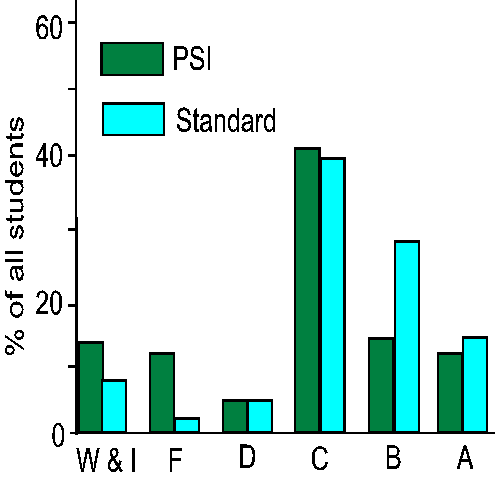
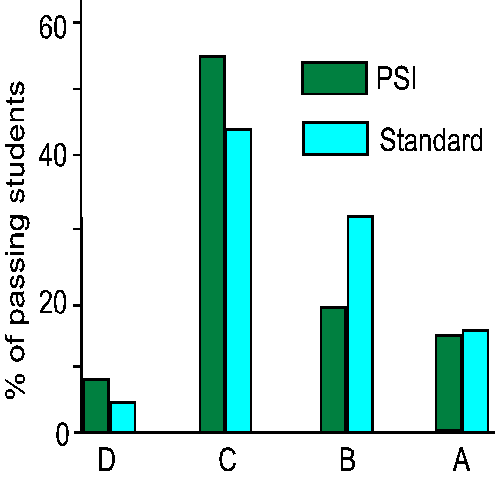
Furthermore, many of those students who scored quite well disliked the system intensely, taking time to come by and tell the teachers about it. This extreme distaste seems to have been the effect of the mastery feature. Apparently, students have little desire to master mechanics. We feel that had we set the pass-fail mark on the unit quizzes at 80 to 85 as suggested by Block (2) we might have reduced student distaste appreciably.
It is also the feeling of the authors that if only those students who completed the course within sixteen weeks were considered, they might show a slight edge over the control group. This, however, would seem to be a doubtful comparison, both because this group would only constitute about 60% of the class and because using more than sixteen weeks if needed seems a rather basic feature of self-pacing.
Considering the lack of cognitive pay-off and the strong student distaste for this instructional system it was not repeated. A secondary reason for its abandonment was the extremely large demands it made upon the time of the teaching staff. It is undoubtedly the most expensive system we have ever tried.
The lack of success with individually paced instruction caused us to look rather carefully at our normal system for using programmed instruction.
The normal system might be described as the way we teach programmed courses when we aren't trying anything new. It is a system which had grown up out of seven years experience in a sort of trial and error manner. Suddenly we realized it worked very well, better indeed than any variation we had tried.
Having decided we had really evolved an extremely effective method of teaching we found we needed a name for it. At the moment we refer to it as Elastically Structured Teaching.
Elastically Structured Teaching is a system that provides a great deal of elasticity for the individual within a rather rigidly structured course.
Under this system students are required to demonstrate their level of mastery of the material each time they complete a two to four hour study unit. Each study unit is a programmed text section which integrates new information, instruction, and practice in solving textbook problems. The student is generally expected to be tested on the new material and will then have an opportunity to discuss the test and the material with his classmates and instructor. The instructor may use any remaining time to show the class his personal tricks and applications for the concept. Table top demonstrations are often used as discussion starters.
Grades are based in large part on traditional style examinations, but the frequent graded quizzes and discussions keep each student informed of his mastery of each concept so that he may review knowledgeably for the more critical examinations.
While classes and quizzes are held on a regularly scheduled basis, attendance is not required. Those students who fall behind may take a make-up quiz in a Self Study center. Students are expected to complete the material before the end of the course, and nearly all of them do. Those who need extra help are encouraged to visit the instructor in his office.
The instructors accept any excuse for a temporary delay in completing a study unit, but no one is excused from completing all work. The individual student seems to respond to this by setting up his own standard of permissible excuses for postponing an assignment.
EST has been quite successful. On common final exams it has proved more effective than traditional teaching methods. (Figure 5). Again, the difference may not be of statistical significance but whatever difference there is favors the EST system.
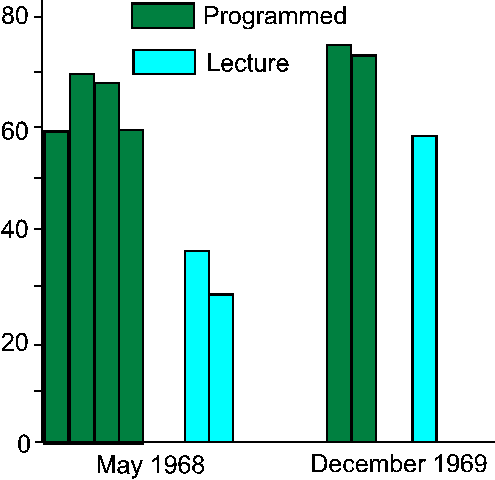
Students have been reasonably happy with the system with the programmed sections usually filling first at registration. A large proportion of those who have had one EST programmed mechanics course take a second one and on questionnaires 50 to 90 percent indicate a willingness to take a second were it available. There are, however those who dislike the EST approach rather intensely. This seems to run at about 10 percent. The remainder of the students are neutral in their feelings about the course.
We attribute the success of the EST system to several causes. First, it provides for the students need to interact with the teacher and provides the teacher with a chance to model proper problem-solving behavior. Second, it provides a strong feeling of structure to the class so that the student knows exactly what is expected of him and when he will be measured. Third, it provides almost continuous feedback so that a student can accurately assess his progress. Fourth, by providing considerable flexibility in the schedule it allows the student to make necessary deviations at the same time that it encourages him to get back to the class schedule as quickly as possible. In a sense he is thus encouraged to substitute self-discipline for teacher imposed discipline. Last, it reinforces persistence self-reliance and dally study.
Although our studies have been confined to mechanics, we believe EST to be applicable to any difficult required course of a problem-solving nature. It is quite likely that other instructional systems are more appropriate to elective courses and courses which load less-heavily on problem-solving.
While we have been able to discern and partially measure some differences between various instructional systems using programmed instruction and between programmed instruction and traditional instruction, no one system can be declared to be completely preferable. In fact, in large scale studies involving many teachers the usual finding is no significant difference in cognitive learning. The affective area is even less clear-cut. However, if no method is demonstrably much better than others, neither is any demonstrably much worse.
On an individual basis, each teacher can, in good conscience, choose the system of instruction that suits him best. If it seems to achieve his objectives in both the cognitive and affective areas, if he likes it and his students like it, there is no real reason why he should not use it. In the absence of demonstrable differences in learning as a result of instructional methods, the teacher's preference is a justifiable deciding factor.